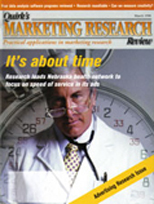It's about time
When you think of visiting your local health clinic, you think about waiting. Waiting to check in, waiting to get into the exam room, waiting to see the doctor. Anderson Partners, an Omaha, Neb., advertising agency, seized on the idea of time as a point of focus for a campaign it developed for University Medical Associates (UMA), an Omaha-area network of health care centers.
The campaign, which began running during the fall of 1996, promises that when patients make an appointment to visit one of UMA’s clinics, the staff will do its very best to get them in to see the doctor within 15 minutes.
The idea for the "15-minute no-wait commitment" campaign grew out of findings from some exploratory focus groups, says Deb Ahl, director of account services, Anderson Partners. "We found that length of wait is a major issue for health care users. In the focus groups, people commented that as they waited, they felt their time was not as important as the doctor’s time. They also felt like they were being ignored. We also found that most respondents were unaware of the University Medical Associates or its clinics. We took that information and developed a campaign that would break UMA out of the pack."
Most of the health care-related advertising in the Omaha market, Ahl says, uses a warm-and-fuzzy approach, as is common in most other markets. So Anderson Partners decided the ads had to be a little edgy if they were to stand out. "We were going in with a lower budget so we felt we needed to zig when the competition zagged so that our advertising didn’t get confused with that of our competitors," Ahl says.
The tag lines for the radio and print ads include "It’s about time," referring both to the 15-minute commitment and the fact that it’s about time that health care facilities take a more consumer-oriented approach. Others include "Does waiting at the doctor’s office make you sick?" and "If seeing a doctor is a pain, call UMA for fast relief."
Awareness rose
The ads began running in 1996, during the spring and fall enrollment periods when people typically make decisions about health insurance plans. "We wanted to have our name out there during enrollment time to make sure that they would look at what UMA had to offer," Ahl says.
Prior to launching the campaign, the agency conducted phone surveys to measure unaided awareness. In the spring of 1997, tracking research was conducted. The results were gratifying, to say the least: from the fall 1996 pre-launch period to spring 1997, unaided awareness of UMA doubled and aided awareness rose substantially as well.
"There was a meaningful segment of the sample that had unaided recall for the waiting room advertising commitment itself, so there was some recognized sponsorship. One of our goals was to make sure that our advertising broke out and that we didn’t have our advertising confused with or tied to another health care facility," Ahl says.
Concerned about acceptance
One obvious concern was getting the doctors to agree to participate in the 15-minute commitment, says Gregg Dahlheim, senior marketing coordinator, Nebraska Health System. (University Medical Associates is an affiliate of Nebraska Health System.) "We were concerned about getting acceptance internally before we began running the ads, so there was a certain amount of sell to the physicians, some of whom were not quite as confident that the 15-minute commitment could be met," Dahlheim says.
But after seeing some figures on how long it was currently taking for UMA’s patients to see doctors, the doctors realized most people were already getting to see their care providers within 15 minutes. "That made it easier. Above all, we want to make sure that the patients feel that they aren’t being ignored and that we acknowledge that their time is important," Dahlheim says.
"We didn’t want UMA to be looked at as the Jiffy Lube of doctors," Ahl says. "The ad copy addressed the fact that the 15 minutes referred to the time spent in the waiting room and that the time of care once in the exam could be longer. The tag line ‘We’ll rush you in, not out’ reinforces that."
Bit of a switch
The ongoing print and radio campaign is a bit of switch for University Medical Associates, which had relied on direct mail in the past as its main advertising vehicle. "In the market we’re in, most health care facilities and clinic locations rely heavily on television. They spend, in relation to us, in some cases almost 10 times as much," Ahl says.
But UMA is getting the most from the campaign. Consumers are clearly noticing the program and so are competitors -- one clinic network has begun promoting its short wait times as well. So any major changes in the campaign will have to wait, Ahl says.
"We want to make sure we’ve hit this strongly before we change it and that’s why we have continued it in a form that has evolved over the past year and a half. At this point we’re looking at continuing that and we’ll do another tracking survey to see where the levels are. If the levels are high enough that we’re comfortable we’ve made an impact and that consumers are fully aware of the program and they can tie it back to UMA as sponsors, then we will look at putting a different twist to it."
